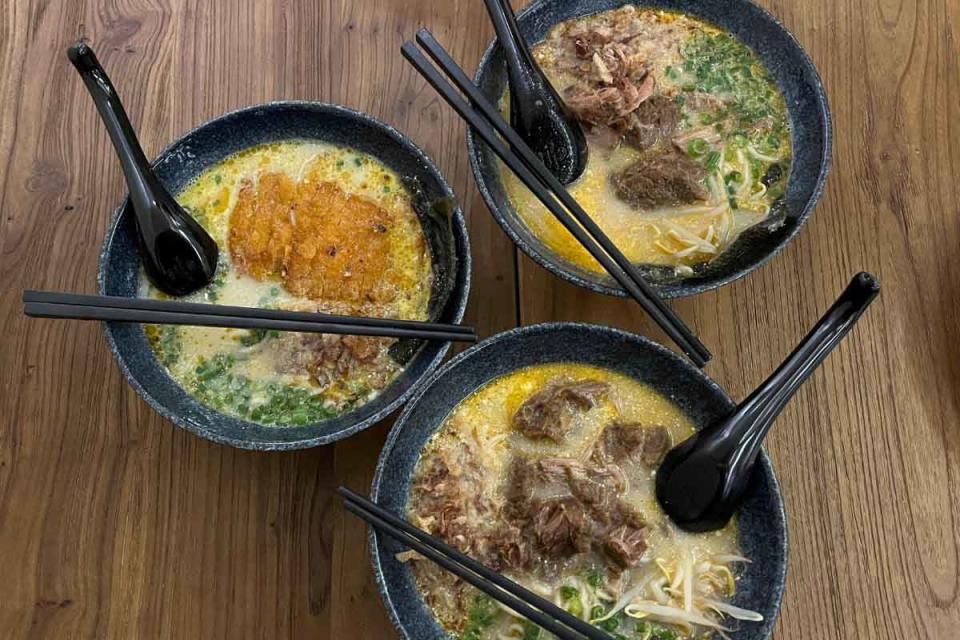Ono Ramen: Owner of Kulon achieves lifelong goal of opening ramen shop
The rise of fusion restaurants is nothing short of remarkable. Growing up overseas, I was fortunate to experience a range of cultures and cuisines. So, when I heard about the opening of Ono Ramen, a Muslim-Japanese-Indonesian fusion ramen restaurant in the heart of Kampong Gelam, I was intrigued.

Founder and owner Haris always loved food, which he credits to his vibrant home of Indonesia. He wanted to open a ramen shop from a young age, but with no prior F&B experience, he had to start somewhere.

In 2018, Haris decided to open a food stall called IndoJava in the canteen of Singapore Polytechnic. Serving authentic Indonesian food, Haris quickly received positive responses. Two years later, he introduced Singapore to Kulon, marking the opening of his very first restaurant, one inspired by his humble food stall all those years ago.

Fast-forward to today, and we witness the inception of Ono Ramen, which he currently runs with his mother. Given his love for cats, Haris has livened up his restaurant with cat decor. Keep your eyes peeled for the 11 hidden cat figurines in the shop!

Haris states that Ono Ramen is his innovative approach to achieving his goal of opening a ramen shop. He incorporates Indonesian flavours into Japanese cuisine but says that it is crucial to still respect and preserve the five elements of ramen: broth, tare (concentrated flavour), noodles, toppings, and oil.
What I tried at Ono Ramen
I must admit, stepping foot into a Japanese Indonesian fusion restaurant left me slightly overwhelmed and unsure of where to begin. Haris recommended their 2 best sellers: the Tauto (Pulled Beef) Ramen (S$14.90) and the Gulai (Chicken Katsu) Ramen (S$14.90).

The restaurant is entirely self-service, so once your meal is ready, you collect it through a small window that overlooks the kitchen.
I always wonder what unique flavours will penetrate my taste buds with any fusion restaurant. This was exactly the case here, and the unpredictability of the meal excited me.

Like with any ramen meal, I first tasted the broth. I initially thought it wasn’t too heavy, with a depth of delicious Indonesian flavours seeping through. Soon after, I got a note of an Indonesian spice that Haris mentioned was rempah (more on that later).

However, my only critique is that it could have been slightly richer in taste, as it was slightly diluted. The hand-pulled ramen noodles were the perfect al dente, and had the perfect bite. The pulled beef was flaky beyond perfection and very tender, complementing the ramen well.

Early on, I was interested in how the broth was produced. Haris took me behind the scenes and talked me through the process of making Ono Ramen’s broth, which takes a lot of time and love. The broth consists of chicken parts, such as the bones and feet, which are simmered overnight. Once ready, the broth becomes slightly cloudy, mimicking the look of tonkatsu.

The incorporation of Indonesian flavours comes through the addition of lime leaves and the rempah. The homemade rempah serves as a substitute for one of the 5 aforementioned elements to ramen – the tare – and makes the base of the broth.
The broth remains the same for every ramen dish except the vegetarian option, which uses mushrooms and miso as its base. Haris says the factor that makes every dish unique is the spice paste added to the broth. The beef ramen uses a homemade tauto paste, whereas the chicken ramen has gulai paste.

When tasting the chicken ramen, I found the the broth noticeably lighter, which I believe is due to the gulai paste. The chicken katsu was very crispy and well seasoned, soaking up the broth very well. The addition of chilli oil added a hint of spiciness, adding to the depth of flavour.

To wrap up the meal, we sampled one of their best-selling side dishes which was the Gyoza (S$6.90). Like you probably are now, I was also scratching my head about how Haris incorporated Indonesian elements into this dish. A layer of bright orange sauce was situated at the bottom of the gyozas, and Haris explained it was their homemade sambal.

The Gyoza was fried perfectly, crispy and airy throughout every bite. The topping consisted of prawn, spring onion and Indonesian spices. I found the sambal to be quite spicy, but as you may know by now, my spice tolerance could do with some work. Nevertheless, it offered a pleasant experience to the meal.
Final thoughts

Having dined at Ono Ramen, I was exposed to a whole new dimension of flavours that I wouldn’t have thought possible. To me, that is the beauty of fusion cuisine – it consistently challenges the norms we are used to.
Overall, the simple menu behind Ono Ramen showcases its motto of focusing on quality. Having just opened, Ono Ramen will have much to look forward to, with Haris telling me he will launch new rice dishes in October.
If I ever find myself in the area, I will not hesitate to return to Ono Ramen and also look to try out their other restaurant, Kulon.
Expected damage: S$12 – S$25 per pax
The post Ono Ramen: Owner of Kulon achieves lifelong goal of opening ramen shop appeared first on SETHLUI.com.


